Use these easy to find herbs for longevity to support your body, increase energy and stamina, and reduce the signs of aging. Many Asian herbs have reputations as adaptogens and longevity herbs, but they can be expensive and hard to source. For long term health and wellness focus on these herbs that are inexpensive and readily available near you to support your health as you get older.
Aging happens at different rates for different people. Some folks are already checking into the retirement home in their fifties while others are spry and energetic in their seventies. Stress, anxiety, environmental factors, and the neglect of self care can make a person age faster. On the other hand, scientists have found that women who look younger than their age, actually have younger skin genetically. How can you keep that youthful look or reverse some of the stiffness and fatigue of aging? While no one has discovered the fountain of youth, there are herbs that you can take to support your body, and that can contribute to the length and quality of your life now.
Many discussions of herbs for longevity focus on their antioxidant properties, others focus on heart health, and still others focus on adrenal support or detoxification.
Herbs for Longevity:
When you read about herbs for longevity the focus is often on Asian herbs with a long history of use as tonics in Traditional Chinese Medicine or Ayervedic medicine. These can be difficult to get, expensive, and of unknown quality. I prefer to use herbs and spices that are readily available to most of us. The herbs and plants that you grow are better for your long term health because they face the same environmental stresses that you do, and have what you need to thrive. The herbs and spices you already use in your cooking are readily available to you. Many of these herbs work well in foods, but can also be used in teas, infusions, or tinctures.
The impact of stress on aging
Stress lowers the body’s natural healing ability, increases blood pressure, and generally is known to cause health challenges. If you are under a lot of stress, you’re more likely to succomb to sickness in the near future. Many of the herbs that are recommended for longevity help the body mitigate its response to stress. These are called adaptogens or alteratives. They help the body adapt to stressful situations and bring the body into balance so that it can work more efficiently.
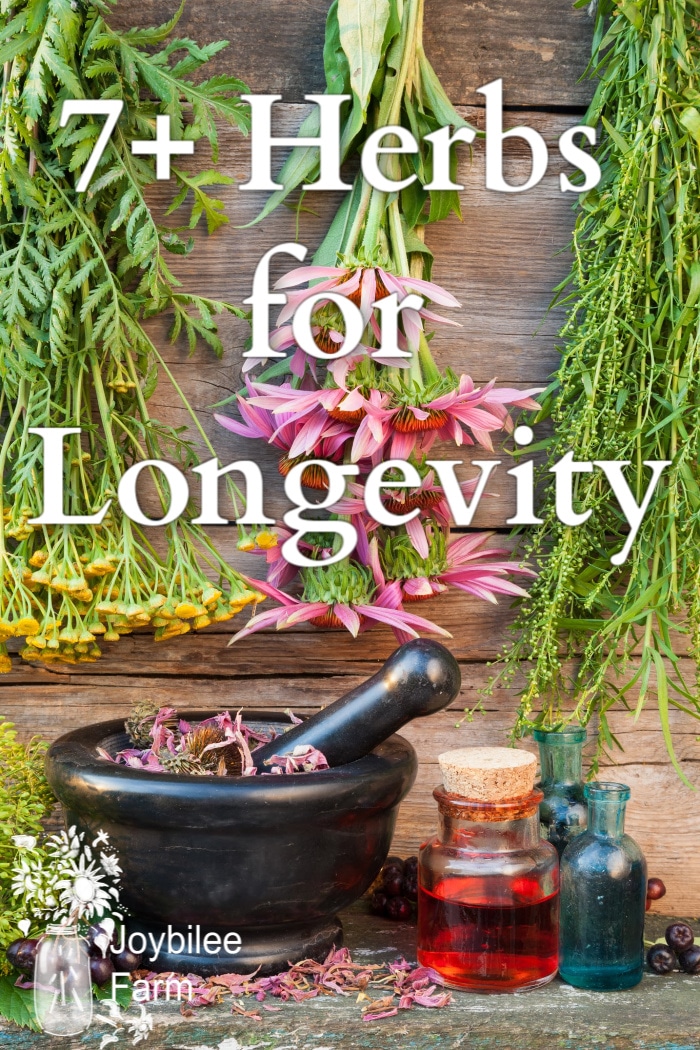
Turmeric
Known for it’s anti-inflammatory properties, turmeric is recommended for join pain, arthritis, chronic inflammation, and general well-being. Turmeric is also anti-tumor and is often prescribed as an adjunct to breast cancer treatment. Turmeric also supports the brain and reduces the risk of dementia. Turmeric is one of the easy to find herbs of longevity. Once it was only available in Indian Food stores, but now you can probably find it in your produce aisle.
Buy fresh organic turmeric for the best results, or chose dried and ground turmeric that is as fresh as possible. Turmeric should be served with a fat, and with black pepper, to increase the bio-availability of the curcumin.
You can grow turmeric indoors, starting from a root with a bud. Turmeric can be grown outdoors successfully in zone 8 or higher, or with winter protection in Zone 7. Zone 8 plants can be grown outdoors in cooler zones for the summer months, as long as they return indoors before the first chance of frost. Turmeric makes a showy garden plant so try your hand at growing this rather than relying on the grocery store.
How to Use:
Eat turmeric regularly. Use it in cooking, use it in condiments, make tea or golden milk. Juice a fresh root with your carrot juice. Be sure to eat turmeric with fat to increase absorption of the active constituent, curcumin. A little black pepper added can increase absorption as well.
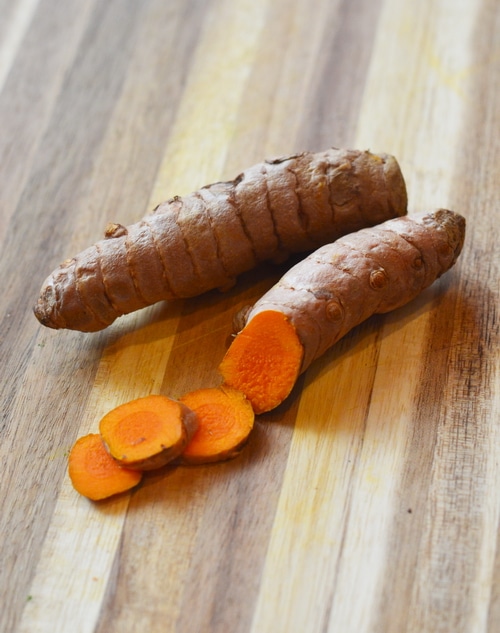
Ginger
Ginger is familiar to most of us. It’s the favor of gingersnaps, ginger bread, and stir fries. Ginger is anti-inflammatory, anti-bacterial, anti-nausea, warming, carminative digestive, anti-cancer, anti-viral,and decongestant. It is a great remedy for colds and flu. It stimulates circulation, breaks up congestion, reduces aches and pains, and eases nausea and vomitting. Use fresh ginger if possible, but if you can’t find organic, fresh ginger in your grocery store, organic ginger spice is a suitable substitute.
Ginger can also be grown from a root bud indoors in cool climates, and outdoors in Zone 8. Hardy to zone 9, ginger needs a long growing season with some heat to multiply it’s root.
Turmeric and ginger together are one of my go-tos to reduce muscle inflammation from exercise, and to handle general aches and pains.
How to Use:
Ginger can be added to foods such as stir-fry, used for hot drinks, or eaten straight or candied. One of my favorite ways to consume ginger is as part of a hot lemon and honey drink. Fresh ginger root can be juiced along with your regular apple-carrot juice shot.

Cinnamon
Cinnamon is a common spice in chai-tea. It is a warming carminative digestive that is often used in festive drinks and associated with Christmas. But cinnamon is a good spice to add to your food year round.
Cinnamon is anti-inflammatory, anti-fungal, antiviral, anti-microbial. One of its super powers is reducing insulin resistance and reducing blood sugar, helping people lose weight. (Source) While many of the scientific studies are done using Cassia cinnamon, Ceylon cinnamon is generally recommended by herbalists as higher amounts can be tolerated without taxing the liver.
You’ll find cinnamon readily at the grocery store. If you plan to use large amounts of cinnamon look for Ceylon cinnamon.
How to Use:
Cinnamon can be combined with ginger in cooking, and used in connection with ginger, turmeric, and tea to make an anti-inflammatory chai, a delicious way to enjoy your herbs for longevity.

Bilberries:
Bilberries and blueberries have been traditionally used for anti-aging, eye health, and brain health. High in antioxidants, they were historically used to improve night vision in fighter pilots during World War 2. These berries are antibacterial, anti inflammatory, support healthy circulation, protect the heart, and reduce free radical damage. (Source. Source) Studies found that different cultivars of blueberries have different antioxidant benefits. Wild blueberries and bilberries vary in the antioxidant benefit with variations in antioxidant capacity during the growing season. Herbalists traditionally recommend bilberries and wild blueberries over blueberries. But the studies done seem to indicate that either is beneficial. Eat them. Eat them regularly. Eat the one that grows close to home. Other black or blue fruits like black currant, black berries, and black raspberries also are high in antioxidants and are protective against aging.
Frozen blueberries are available year round in the grocery store. Bilberries and low bush blue berries are available in most of the Northern Hemisphere. Blueberries require acidic soil to grow well. They are heath family plants that thrive where heather thrives, on peaty soils.
How to Use these herbs for longevity:
Eat them, sprinkle them on cereal, add them dried to tea, eat them with yogurt. Eat them regularly to get the most benefit.
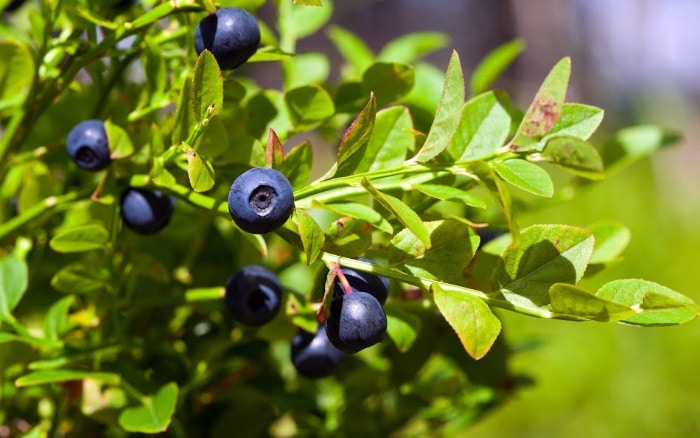
Chamomile
Chamomile is the a white, daisy flower with an apple scent. It grows easily in most gardens. It’s used around the world to ease bloating and indigestion, to reduce “nerves” and to aid sleep. You can certainly grow your own. Chamomile is available as a tea at most grocery stores. Herb supplies usually sell chamomile as a bulk herb as well.
Chamomile is anti-spasmodic, bitter, digestive, anti-microbial, anti-viral, and antioxidant. It relieves tension associated with stress. Chamomile essential oil is a rich blue color and especially useful for skin health. Use a few drops in your daily eye serum to reduce the appearance of fine lines and support the elasticity of the skin.
Personally, I (Sarah) take chamomile tea when I get worked up and over stressed, it always seems to help. For a therapeutic dose, if you’re using normal tea bags, you need at least 3 tea bags, and a ten minute steep. Chamomile contains volatile oils so always steep in a covered tea pot to prevent them from dissipating into the air.
How to Use:
Chamomile infused oil can be used in salves for skincare. Tea made from the flowers can double as a hair or skin rinse, as well as a hot drink.
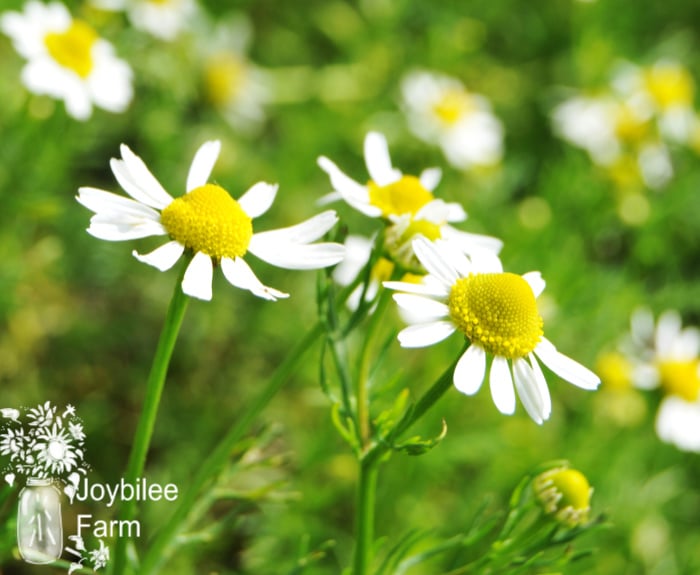
Nettles:
Nettles are a wild and weedy herb that are full of potent anti-aging properties. The leaves are rich in minerals and vitamins are are often used as a spring tonic or daily mineral tonic tea. They support lung and kidney health and support the immune system during hay fever season. Though the goodness found in the leaves is there, even when the plant becomes more fiberous. Nettle roots are a potent prostate tonic, that has been prescribed in the EU for prostate enlargement. According to Agatha Noveille, herbalist and author, nettle seeds have adaptogenic qualities, restoring energy and building stamina.
But you probably won’t find nettle seed for sale. Thankfully, nettles grow throughout the northern hemisphere. You may find them at the edge of the woods or near streams and creeks, growing wild. If you don’t find them growing near you, you can plant them in an out of the way spot in your garden.
How to Use:
Gather the tiny seeds in the fall by shaking the plant with gloved hands over a bowl. Sift the seeds. Then use them as a sprinkle over oatmeal, in herb salt blends, or added to granola bars or green smoothies. Use them liberally.
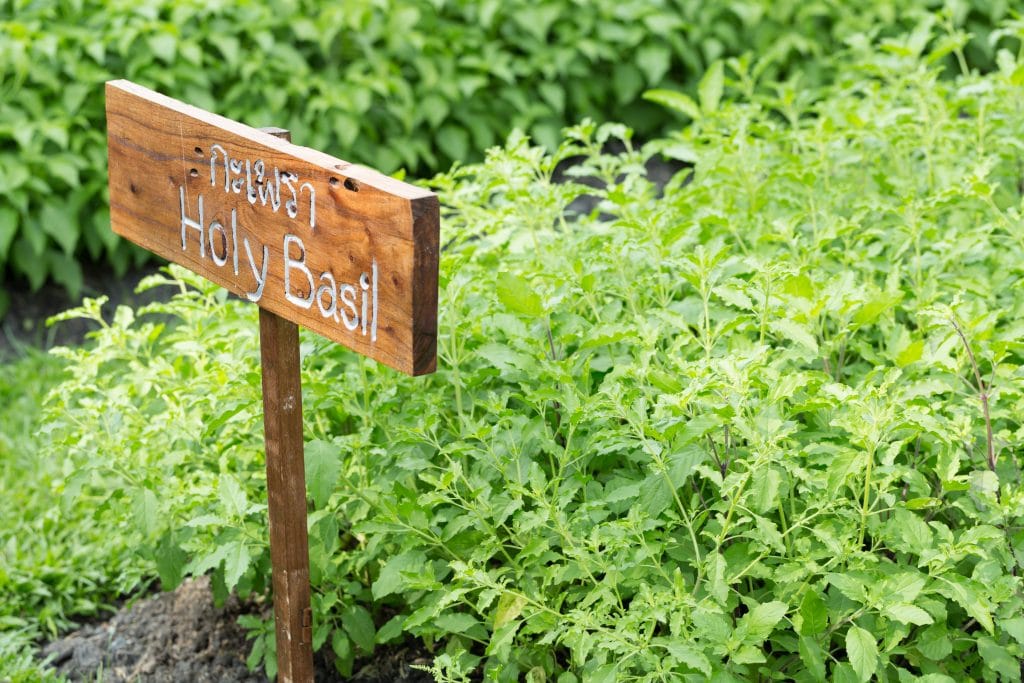
holy basil plants holy basil vegetable acreage Herb of Thailand
Holy basil (tulsi)
Another adaptogenic herb, holy basil is a nervine, immune tonic, and carminative digestive. It is antiviral, antioxidant, and helps reduce cold and flu symptoms. The entire, above-ground plant can be utilized for tea. Holy basil has both bitter and spicy notes. There are several pre-made tea blends available that contain tulsi.
Tulsi is an ayervedic tonic herb with more than 3,000 years of traditional use.
Tulsi is perennial in zone in zone 10 but grown as an annual in other gardening zones. Grow it like basil but put it in full sun. Tulsi requires a little more heat than basil to grow well. Tulsi can also be grown indoors successfully.
How to Use:
Combine holy basil with other relaxing herbs, like chamomile and mint, as a therapeutic tea. Teas using the herbs for longevity should be steeped for at least ten minutes, in a covered pot to hold in the heat.
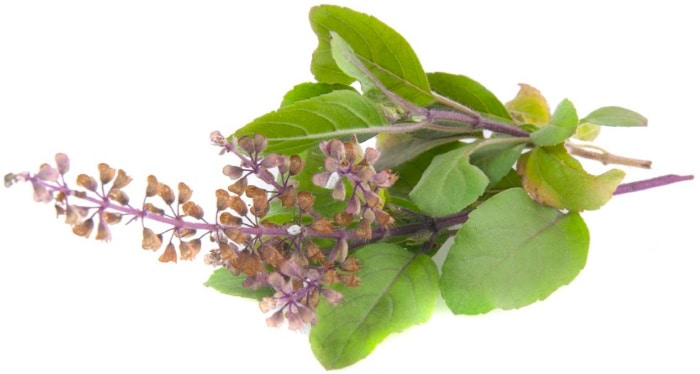
Burdock root
Burdock is a nutritive and supportive herb, that helps in detoxification. It is highly antioxidant, anti-tumor, alterative, and anti-inflammatory. It is a beneficial adaptogen to help with recovery from illness, supporting glandular activity, in the lymph, liver, pancreas, prostate, and spleen.
Burdock is native to North America and can be grown in an out of the way spot your garden. It can grow quite large in the second year and can become weedy if it is allowed to go to seed. But it is the root of the first year plant that is used in herbal medicine. So plan to harvest the root in the fall of the first year and you won’t have this issue.
Use caution if choosing to wild craft burdock, as it can grow in the vicinity of nightshade family plants of similar appearance.
How to Use: Use shredded dried burdock root in tea blends, or use the dried root to make tincture for internal use. The infused oil is often used in skin-care salves. Fresh burdock root is a japanese delicacy called “gobo” that is used as a vegetable, stir fried much like carrots or parsnip. The root contains inulin which supports a healthy microbiome.

Dandelion:
Another weedy plant, dandelion is tonic and bitter, very helpful for supporting liver function. Dandelion is also anti tumor. Both the root and leaves can be used. In North America dandelion is easy to wild craft. However, caution should be used to make sure that the plants have not been sprayed with herbicide. Wild craft dandelions from your own property whenever possible, so you know that they are grown without pesticide and herbicides.
Dandelion is rich in iron and minerals and is useful
How to Use:
Dandelion greens can be consumed as food, flowers can be used in tea, or mead, and the roasted root can be used as a coffee substitute. Any of these methods can give the herbal benefits. Dandelion flower infused oil can also be used in skin-care.
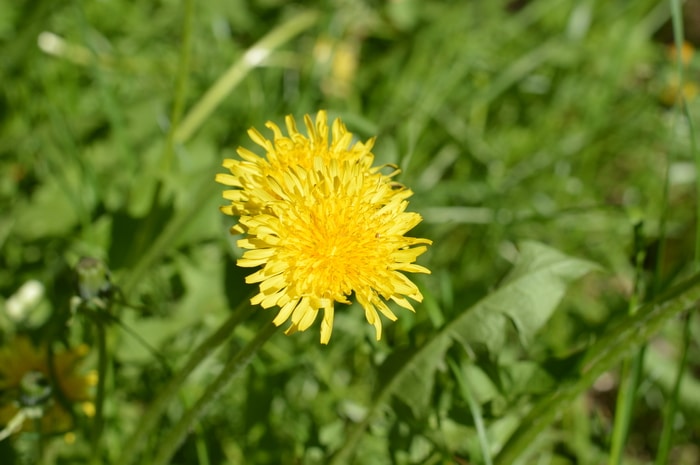
Dandelion can be grown and harvested in your own backyard, just make sure that no chemical weed control measures have been used on them. Dandelion should not be harvested or consumed if you have a latex allergy. Contact dermatitis has been noted from extended contact with the stem latex.
How to Use:
Enjoy young dandelion greens as a fresh salad, or made into dandelion green pesto, prepare autumn harvested roots for medicinal use or a coffee substitute. Flowers can also be harvested and dried for use in teas, made into mead, or dried and infused in oil for use in skin-care.
Local Herbs for Longevity
These herbs for longevity are just a sample of some of the local, well known, and helpful plants available close to your home. Take advantage of the benefits of the herbs around you, and the spices you normally use to increase your comfort and overall health as you get older.
Your Turn:
Which of these longevity herbs are you already familiar with? Which of these plants and herbs to you regularly use in your life?



Leave a Reply